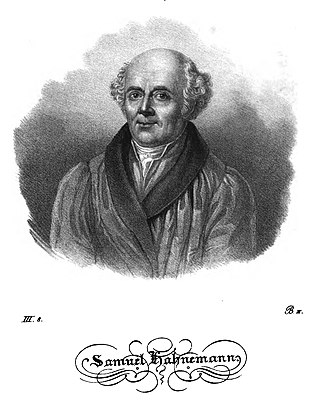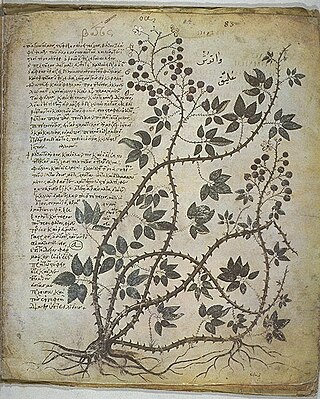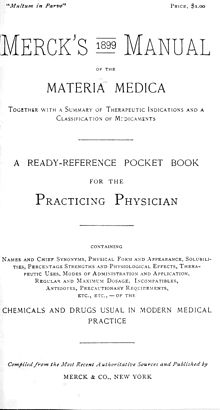The following outline is provided as an overview of and topical guide to health sciences:

Homeopathy or homoeopathy is a pseudoscientific system of alternative medicine. It was conceived in 1796 by the German physician Samuel Hahnemann. Its practitioners, called homeopaths, believe that a substance that causes symptoms of a disease in healthy people can cure similar symptoms in sick people; this doctrine is called similia similibus curentur, or "like cures like". Homeopathic preparations are termed remedies and are made using homeopathic dilution. In this process, the selected substance is repeatedly diluted until the final product is chemically indistinguishable from the diluent. Often not even a single molecule of the original substance can be expected to remain in the product. Between each dilution homeopaths may hit and/or shake the product, claiming this makes the diluent remember the original substance after its removal. Practitioners claim that such preparations, upon oral intake, can treat or cure disease.

Veterinary medicine is the branch of medicine that deals with the prevention, management, diagnosis, and treatment of disease, disorder, and injury in animals. Along with this, it deals with animal rearing, husbandry, breeding, research on nutrition, and product development. The scope of veterinary medicine is wide, covering all animal species, both domesticated and wild, with a wide range of conditions that can affect different species.

Impetigo is a bacterial infection that involves the superficial skin. The most common presentation is yellowish crusts on the face, arms, or legs. Less commonly there may be large blisters which affect the groin or armpits. The lesions may be painful or itchy. Fever is uncommon.

Materia medica is a Latin term from the history of pharmacy for the body of collected knowledge about the therapeutic properties of any substance used for healing. The term derives from the title of a work by the Ancient Greek physician Pedanius Dioscorides in the 1st century AD, De materia medica, 'On medical material'.
Premenstrual syndrome (PMS) is a disruptive set of emotional and physical symptoms that regularly occur in the one to two weeks before the start of each menstrual period. Symptoms resolve around the time menstrual bleeding begins. Different women experience different symptoms. Premenstrual syndrome commonly produces one or more physical, emotional, or behavioral symptoms, that resolve with menses. The range of symptoms is wide, and most commonly are breast tenderness, bloating, headache, mood swings, depression, anxiety, anger, and irritability. To be diagnosed as PMS, rather than a normal discomfort of the menstrual cycle, these symptoms must interfere with daily living, during two menstrual cycles of prospective recording. These symptoms are nonspecific and are seen in women without PMS. Often PMS-related symptoms are present for about six days. An individual's pattern of symptoms may change over time. PMS does not produce symptoms during pregnancy or following menopause.

Diazepam, first marketed as Valium, is a medicine of the benzodiazepine family that acts as an anxiolytic. It is commonly used to treat a range of conditions, including anxiety, seizures, alcohol withdrawal syndrome, muscle spasms, insomnia, and restless legs syndrome. It may also be used to cause memory loss during certain medical procedures. It can be taken by mouth, inserted into the rectum, injected into muscle, injected into a vein or used as a nasal spray. When given into a vein, effects begin in one to five minutes and last up to an hour. By mouth, effects begin after 15 to 60 minutes.

Geriatrics, or geriatric medicine, is a medical specialty focused on providing care for the unique health needs of older adults. The term geriatrics originates from the Greek γέρων geron meaning "old man", and ιατρός iatros meaning "healer". It aims to promote health by preventing, diagnosing and treating disease in older adults. There is no defined age at which patients may be under the care of a geriatrician, or geriatric physician, a physician who specializes in the care of elderly people. Rather, this decision is guided by individual patient need and the caregiving structures available to them. This care may benefit those who are managing multiple chronic conditions or experiencing significant age-related complications that threaten quality of daily life. Geriatric care may be indicated if caregiving responsibilities become increasingly stressful or medically complex for family and caregivers to manage independently.

Gastritis is inflammation of the lining of the stomach. It may occur as a short episode or may be of a long duration. There may be no symptoms but, when symptoms are present, the most common is upper abdominal pain. Other possible symptoms include nausea and vomiting, bloating, loss of appetite and heartburn. Complications may include stomach bleeding, stomach ulcers, and stomach tumors. When due to autoimmune problems, low red blood cells due to not enough vitamin B12 may occur, a condition known as pernicious anemia.

Hyperphosphatemia is an electrolyte disorder in which there is an elevated level of phosphate in the blood. Most people have no symptoms while others develop calcium deposits in the soft tissue. Often there is also low calcium levels which can result in muscle spasms.
A medical classification is used to transform descriptions of medical diagnoses or procedures into standardized statistical code in a process known as clinical coding. Diagnosis classifications list diagnosis codes, which are used to track diseases and other health conditions, inclusive of chronic diseases such as diabetes mellitus and heart disease, and infectious diseases such as norovirus, the flu, and athlete's foot. Procedure classifications list procedure code, which are used to capture interventional data. These diagnosis and procedure codes are used by health care providers, government health programs, private health insurance companies, workers' compensation carriers, software developers, and others for a variety of applications in medicine, public health and medical informatics, including:
Merck refers primarily to the German Merck family and three companies founded by the family, including:
Odynophagia is pain when swallowing. The pain may be felt in the mouth or throat and can occur with or without difficulty swallowing. The pain may be described as an ache, burning sensation, or occasionally a stabbing pain that radiates to the back. Odynophagia often results in inadvertent weight loss. The term is from odyno- 'pain' and phagō 'to eat'.
Scottie Cramp is a disease in Scottish Terriers causing spasms and hyperflexion and hyperextension of the legs. It is caused by a disorder in serotonin metabolism that causes a deficiency of available serotonin. It is inherited as an autosomal recessive trait.
The Merck Veterinary Manual is a reference manual of animal health care. It was first published by Merck & Co., Inc. in 1955. It contains concise, thorough information on the diagnosis and treatment of disease in a wide variety of species. The Manual is available as a book, published on a non-profit basis. Additionally, the full text can be accessed for free via the website, or downloaded in its entirety via an app. In January 2020, the website was redesigned with a more helpful search function without advertising. Interactive features on the website include quizzes, case studies, and clinical calculators. In addition, there are animal health news summaries and commentaries.

Finley Ellingwood was a doctor of eclectic medicine who is the author of the influential American Materia Medica, therapeutics, and pharmacognosy in 1919. Ellingwood was an active Chicago physician with many years experience, and an acknowledged expert in obstetrical/gynecological medicine. He was a vocal advocate of women physicians, and edited Ellingwood's Therapeutist for many years. His brand of Eclectic Medicine differed from the more subdued Cincinnati style as mentored by Scudder, Lloyd, Fyfe, and Felter.

A medical encyclopaedia is a comprehensive written compendium that holds information about diseases, medical conditions, tests, symptoms, injuries, and surgeries. It may contain an extensive gallery of medicine-related photographs and illustrations. A medical encyclopaedia provides information to readers about health questions. It may also contain some information about the history of diseases, the development of medical technology uses to detect diseases in its early phase. A licensed physician should be consulted for diagnosis and treatment of any and all medical conditions.
Mark Howard Beers was an American geriatrician whose research on drug interactions among the elderly led to the creation of the eponymous Beers criteria, which lists prescription medications that may have deleterious side effects in older patients.
The Merck Manuals are medical references published by the American pharmaceutical company Merck & Co., that cover a wide range of medical topics, including disorders, tests, diagnoses, and drugs. The manuals have been published since 1899, when Merck & Co. was still a subsidiary of the German company Merck.














